An army of 800 women protects Ecuador’s water
In the country’s central mountain range, mothers and wives are challenging domestic machismo and defending vital water resources
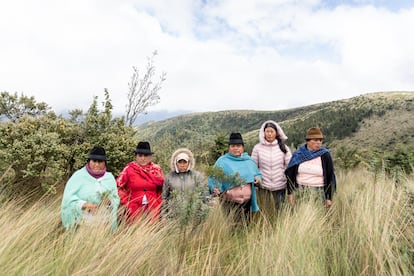
The Pucahuaico River, which runs through the Toacaso parish in Cotopaxi province, 60 miles (100 kilometers) south of Quito, Ecuador, was fast-flowing and healthy 40 years ago. There was enough water for everything, even for icy cold baths. Around that time, the Federation of Peasant Organizations of North Cotopaxi (UNOCAN) began to plant pine trees in the surrounding moors with the support of CESA, a local non-governmental organization that promotes agrarian and rural development projects. They thought they were doing great reforestation work. “We gathered 400 people and even took the town band to plant pine trees in a community project,” said Yolanda Guamán, president of the Organization of Indigenous and Peasant Women Sowing Hope (OMICSE). “But the more the trees grew, the more the nearby water sources dried up.”
Today the river is almost dry, and people can barely fill a bucket from its waters, now polluted with arsenic and pesticides applied to the nearby potato and bean crops. The water sources in the highland moors are now threatened by encroaching agriculture. “We’re concerned — we ask ourselves what we can do as a women’s organization,” said Guamán.
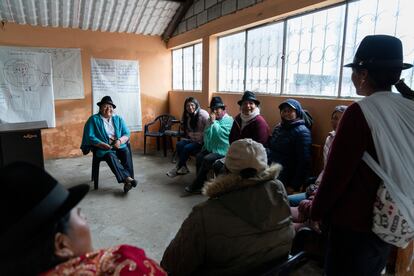
Establishing OMICSE, which now has 800 members, was key to activating the local women. Before it was created 39 years ago, women were confined to household chores and backbreaking community projects. They depended financially on their husbands, who also made all the household decisions. Even worse, women were not allowed to sit on chairs or vote in community meetings. Despite the collaborative efforts of women from 21 communities, they remained stifled by UNOCAN, the parent organization. As much as they tried to be independent, they were constantly curtailed. In 2006, the organization finally gained legal status and autonomy, marking a historic turning point in social dynamics.
The first step was to conduct workshops and training on collective and women’s rights to counter domestic abuse. “The people running the workshops showed us that men and women have equal rights,” said Guaman. “Our husbands and sons were trained too, which helped them understand. It’s not perfect, but now 85% of households don’t mistreat women like that anymore.”
With support from development organizations, productive projects were launched by these women, enabling them to gain some financial autonomy. In the past, husbands were the primary income earners, with many having to leave their cantons and towns for jobs as stevedores, gardeners and construction workers. These women now earn their own income by selling vegetables, guinea pigs and chickens in fairs and markets.
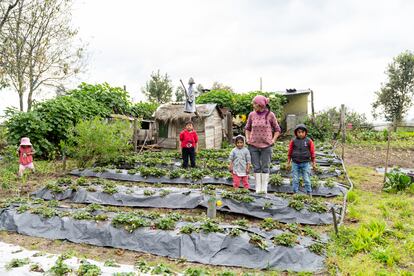
The community work enabled women to assert their rights and reclaim their voices. They achieved financial independence by producing food and caring for the land, creating a virtuous cycle of self-reliance. But soon their efforts turned to preserving water sources and the páramos — the highland moors. The high-altitude páramos of Ecuador are a wetland ecosystem that covers 7% of the country. They sit at almost 11,000 feet (3,300 meters) above sea level and collect rain and moisture from clouds, which it filters through porous soil. The water ultimately flows into rivers and streams, supplying up to 90% of the country’s drinking water. The páramo plays a crucial role in mitigating global warming by acting as an exceptional carbon sink. Elevated land, cool and moist climate, and volcanic, wet soils enable retention of abundant organic material. Topped off with tall vegetation growth, the páramo retains more carbon per hectare than lowland rainforests.
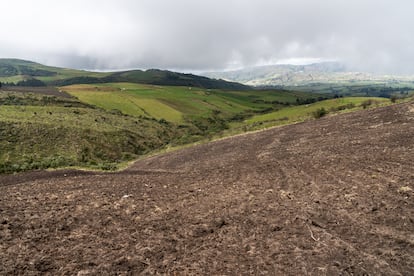
The páramo covers 37% of the Cotopaxi province and spans over 770 square miles (2,000 square kilometers), but the health of the ecosystem has been under threat for some time. Recently, Leonidas Iza, president of the Federation of Indigenous Peoples of Ecuador (CONAIE), has been speaking out against the agricultural encroachment, inappropriate reforestation and water pollution that is endangering the páramos. Iza has urged the Ministry of the Environment and the provincial government to develop comprehensive plans and economic alternatives that promote responsible land use. Community organizations could take charge of educating landowners in environmental protection, but navigating the murky waters of public policies and development funding will prove more difficult.

“I am familiar with the moors of the Cotopaxi province and can say that 80% of them are degraded,” said Washington Pruna, a forest engineer and independent consultant who has worked with the Toacaso community. “The vegetation cover is only 20 centimeters [8 inches] high and no longer fulfills the moor’s function. That’s why the work of this women’s organization is important. Their efforts have led to new protected areas, the definition of agricultural borders and fewer livestock grazing in the moors.”
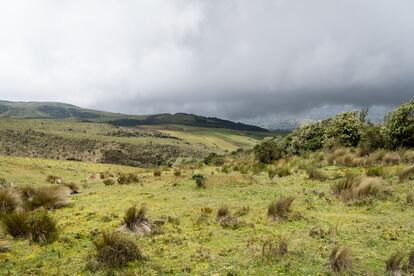
But their efforts have faced challenges from landowners who refuse to make changes. The CARE organization has helped with planting native vegetation and building fences around water sources, but landowners often demand payment for access. OMICSE’s president worries about water wars within a decade if the moors are not preserved properly.

To reach the páramos of the Cotopilaló community, we drive uphill over a narrow and rutted road (four-wheel drive is a must) for 40 minutes. As we near the destination, the thick mist around us disappears, unveiling the stunning southern side of Mt. Iliniza. A fresh breeze rustles through the tall grass and alverjilla shrubs (a medicinal plant used to treat inflammation) that grow along the road. An irrigation ditch channels water from the páramo to a nearby reservoir with pipelines to distribute it to the nearby communities.
Beneath us lies the protected páramo — a moist bed of robust vegetation and symmetrical shapes. The tall grass is a healthy sign. Cattle once grazed here, but the owners switched to llamas and later sold them. People would set fires to flush out and catch the rabbits. The ecosystem was only able to revive after hunting was banned and all the livestock removed. Pruna says the delicate páramo soil erodes easily and takes years to restore after being depleted by intensive agriculture.
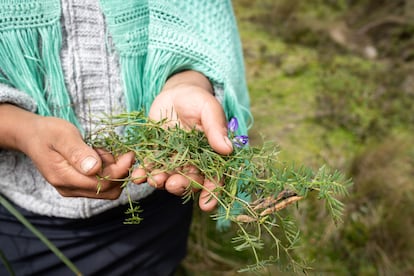
The road flattens out and ends at a ravine. Ahead of us is about 10 acres (4 hectares) of neglected land with depleted soil. The stand of pine trees around it should be cut down to conserve water, but that would mean cutting a road into the mountain. This is where we see the two faces of the páramo — conservation and exploitation. About conservation, Pruina told us, “This whole sector has been 95% reclaimed by planting native flora. As plants grow taller, they cover more soil, reducing evaporation and increasing water storage. In contrast, deforested areas with sparse vegetation and constant livestock activity cause high rates of evaporation and water loss.”
The community organization has effectively mitigated damage to the Cotopaxi páramos, but the fight for relevant public policies and development tools continues. According to Pruna, the community-based approach is exemplary, but compensation policies must be established by central and local governments for all parties involved — villagers, local companies, and NGOs alike — in order to maintain food production and generate income.
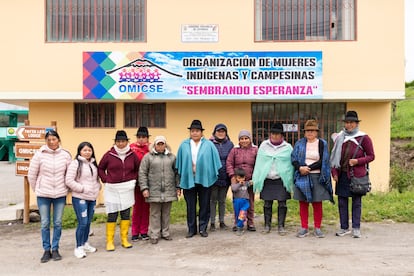
Sign up for our weekly newsletter to get more English-language news coverage from EL PAÍS USA Edition
Tu suscripción se está usando en otro dispositivo
¿Quieres añadir otro usuario a tu suscripción?
Si continúas leyendo en este dispositivo, no se podrá leer en el otro.
FlechaTu suscripción se está usando en otro dispositivo y solo puedes acceder a EL PAÍS desde un dispositivo a la vez.
Si quieres compartir tu cuenta, cambia tu suscripción a la modalidad Premium, así podrás añadir otro usuario. Cada uno accederá con su propia cuenta de email, lo que os permitirá personalizar vuestra experiencia en EL PAÍS.
¿Tienes una suscripción de empresa? Accede aquí para contratar más cuentas.
En el caso de no saber quién está usando tu cuenta, te recomendamos cambiar tu contraseña aquí.
Si decides continuar compartiendo tu cuenta, este mensaje se mostrará en tu dispositivo y en el de la otra persona que está usando tu cuenta de forma indefinida, afectando a tu experiencia de lectura. Puedes consultar aquí los términos y condiciones de la suscripción digital.
More information
Archived In
Últimas noticias
There is as much life left to discover on planet Earth as that which is already known
Dozens presumed dead, around 100 injured in fire at Swiss Alps bar during New Year’s celebration
Is porn for women different from conventional porn? We spoke to those who make it
Cartagena de Indias is sinking: What can the city do to mitigate it?
Most viewed
- Reinhard Genzel, Nobel laureate in physics: ‘One-minute videos will never give you the truth’
- David King, chemist: ‘There are scientists studying how to cool the planet; nobody should stop these experiments from happening’
- Sinaloa Cartel war is taking its toll on Los Chapitos
- Oona Chaplin: ‘I told James Cameron that I was living in a treehouse and starting a permaculture project with a friend’
- The Interoceanic Train, the Mexican alternative to the Panama Canal









































